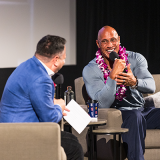A Conversation with Pam & Tommy’s Assistant Art Director Alumni Spotlight: Allison Krumwiede (MFA PD '15)
April 26, 2022
The new hit show Pam & Tommy starring Lily James and Sebastian Stan has swept the internet by storm. The drama miniseries tells the story of Pamela Anderson and Tommy Lee’s honeymoon sex tape being stolen and leaked to the public. The story, coming from mid-90s Hollywood – full of nightclubs, Malibu mansions, beaches, and lots of alcohol – lends a great deal of its beauty and nostalgia to the research and precision that went into Production Design, Costuming, and Hair and Makeup. We had the chance to speak to alumni Allison Krumwiede, Assistant Art Director on Pam & Tommy, about her time with the show and her best advice for students looking to follow a similar career path:
Please share your career path with us: how did you go from being a Master’s Student studying production design to working on projects like Dog, Pam & Tommy, and Promised Land?
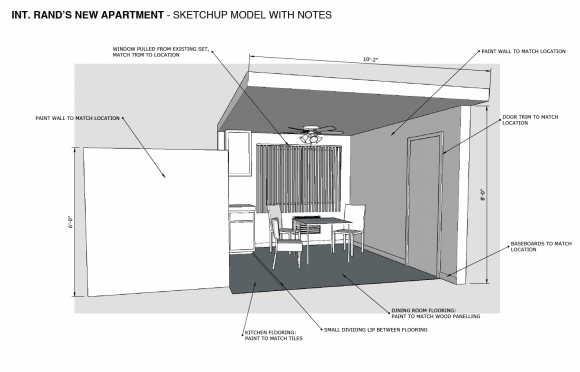
After graduating from Chapman, I worked as a set dresser for the Queen Mary’s Dark Harbor while working on various music videos and digital shorts. These projects allowed me to meet other creatives and gain experience working on projects with a limited budget and short time frame. With this experience – whether it’s a project like Dog, Pam & Tommy, or Promised Land – I am always reminded that obstacles happen on any project, whether it’s a huge feature with a well-known crew or a small non-union/influencer based series for YouTube.
The experience I have gained after graduating has been wonderful, and I’m still thankful for the alumni of the Production Design program who helped create a growing network amongst our alumni and students.

Still of Rand’s New Apartment – Pickup Shot – Pam & Tommy
What was it like working on such a popular project like Pam & Tommy? What was your favorite memory from your time with the show?
Pam & Tommy is an interesting situation because I was only on the show during the very end of the series when they were doing a bunch of pick-up shots that needed to happen all at once. The time I spent on that show felt like a relay race! The original designer had moved onto another project, but thankfully the new Production Designer, David Wilson, and I put our heads together. We went full force into prepping a bunch of swing sets that needed to be built and ready for camera within DAYS, all while going on tech scouts and prepping locations for the current episode they were still shooting.
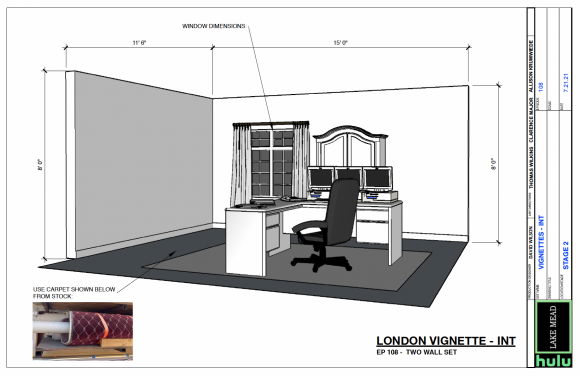
David gave me the task to rebuild a corner of Rand Gauthier’s apartment that had originally been used a few episodes earlier, BUT since they couldn’t return to the location, I worked with our Construction and Set Decorating crew and recreated that section of the apartment, as well as a two wall set, squeezed in the middle of an already packed sound stage. Also, while putting this set together, we had to create four vignettes of apartments/offices based in various countries (which you see in Episode 108). David and I were picking out paint colors, I was running to Linoleum City and picking out rolls of flooring, working with our construction team – all while making sure these vignettes fit in the small sound stage with everything else. It was a busy show!
What is your personal design style? Are there some design elements that are consistent throughout all the projects that you have worked on?
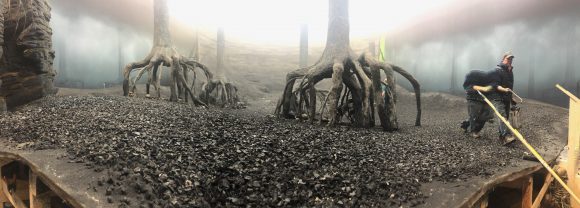
Behind the scenes of Phantom Island – Jupiter’s Legacy
My personal design style is a mixture of bright colors, large grand theatrical set pieces, and loads of expressionism. None of these design styles have really made it into the projects I have worked on so far, but I know I still have plenty of time to find that dream project.
When it comes to consistency regarding design elements in each project I have worked on, while it doesn’t feel like Jupiter’s Legacy and Promised Land would have anything in common, I feel that I have repeatedly worked on shows that display various time periods. These projects require lots of research and knowledge of time, place, and people living within it. For Jupiter’s Legacy, we had to recreate life during the 1929 stock market crash and the Dust Bowl. For Mulan, I worked with Tom Wilkins and Grant Major to research the military architecture and styles of the Tang Dynasty. For Promised Land, we had to jump from 1987 to the present-day with each episode. Every project I have worked on that has dealt with focusing on a period of time involves making sure graphics, set dressing, and the overall design period is correct.
While being very different from each other, these projects have made my job entertaining and educational. I am constantly learning and researching, which always has a way of helping me with future projects I work on.
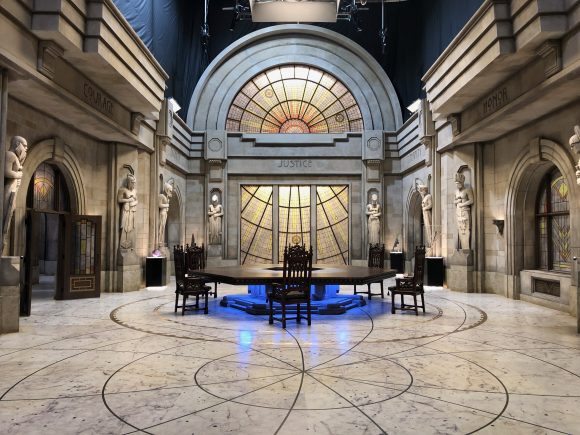
Chamber of Wisdom – Jupiter’s Legacy
How were your experiences different working for live theatre like Rent: Live versus film and TV sets?
Rent: Live is another interesting situation because I worked as an Illustrator (which is what I originally joined the Art Directors Guild as before becoming an Assistant Art Director!). With this project, I worked with the Art Director to make sure two big elements were shown in the final illustration: 1) it felt like an architectural drawing from the 1989-1990 time period that Rent was set in, and 2) that it could be read clearly on screen.
Rent: Live was a fast-paced show, so the turnaround was quick, but working as an illustrator is a different experience since your main focus is the artwork you need to create, and once it’s turned in, you’re off to the next job!
Were there any specific resources (i.e., certain professors, courses, workshops, career advising, etc.) at Chapman that contributed to your career journey post-graduation?
I would definitely say that all of my instructors at Chapman were great advisors for me during and after my time there. I came from an illustration background, having received my BFA from Art Center College of Design and working as an Illustrator. I understood the impact of telling a story through an image, but my instructors at Chapman taught me how to bring that image to life in a three-dimensional world.
During my second year, I met Tom Wilkins when he came to Chapman to help John Chichester. Tom became a great mentor of mine and brought me on as his Art Department PA to features like Magic Came and Mulan. A few years later, I became his Assistant Art Director on Dog and Pam & Tommy. I learned so much while working alongside Tom, and now I am so thankful for times when an Art Director calls him asking about me, and he tells them, “Hire her!” without any hesitation.
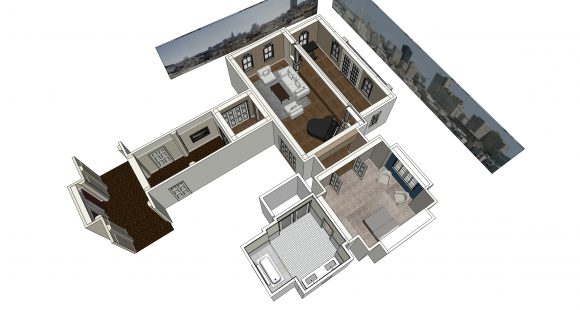
Hotel Room – Dog
What is the best advice you have received that you would give to current students?
Each project you work on will be completely different from the last. Designers are like fingerprints: no two are the same, but you will always learn something from each designer that will help you in the future.
Always be willing to take on a challenge. Challenges allow you to grow and be a better designer and person. Step out of your comfort zone and never be afraid to ask questions.
Respect everyone. I was definitely humbled when working as an Art PA and understood we all have to start somewhere, BUT the moment you move up and are no longer a PA, please remember to treat PAs with respect. Those people are the future of our industry.
And lastly, something I learned from colleagues, which I wish I had learned sooner in my creative career, is: “Work to live, don’t live to work.” I love what I do and am very thankful for the career that I have, but I always remind myself to enjoy the life I have built around me and be grateful for what I have. It’s just a show – don’t forget that life exists outside the studio!
Any parting thoughts or advice?
Keep being inspired and never stop being creative! Go to museums, look at art and architecture as close as you can, draw, paint, walk through nature, keep your creativity flowing.


